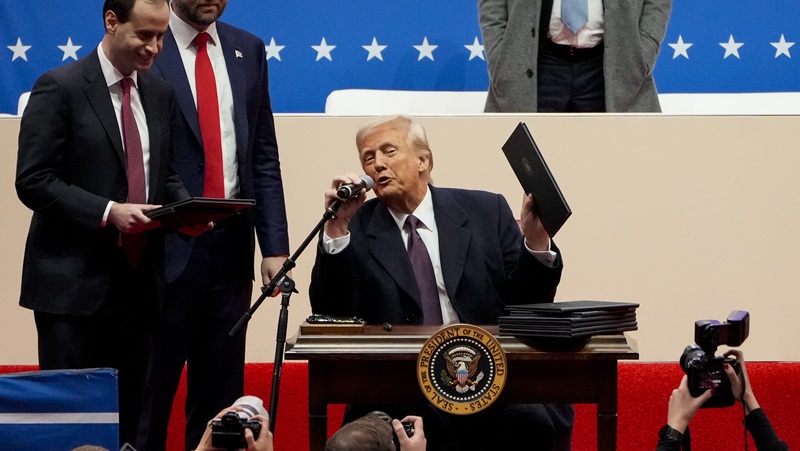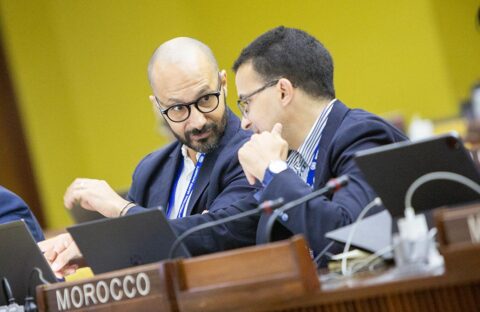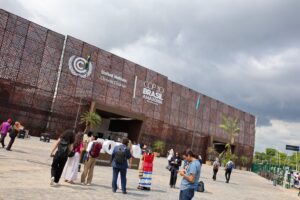Global greenhouse gas emissions are estimated to decline over the next decade but at a pace “still not nearly fast enough” to avoid the worst climate impacts, the UN’s top climate official warned as a partial assessment of new national climate plans was released.
UNFCCC Executive Secretary Simon Stiell said global emissions are expected to fall by around 10% by 2035 based on a preliminary assessment of new national climate targets (NDCs) announced by countries that produce nearly 60% of the world’s greenhouse gases.
The Intergovernmental Panel on Climate Change (IPCC) has said that countries should cut their emissions much more rapidly, with a 60% drop from 2019 required by 2035 to limit global warming to 1.5C.
“Ten years after we adopted the Paris Agreement, we can say simply – it is delivering real progress,” said Stiell. “But it must work much faster and fairer, and that acceleration must start now.”
Country delays hamper UN review
Countries are expected to discuss the shortfall in emissions-cutting ambition at next month’s COP30 summit in Belém, Brazil, but it is still unclear what form their response will take.
Stiell said COP30 needs to show nations are still fully on board for climate co-operation, as well as accelerating implementation across all economic sectors and connecting climate action to people’s lives.
But with only two weeks to go until leaders arrive in the Amazon city, most nations – including several big emitters – are yet to even publish an updated climate plan, known as a nationally determined contribution (NDC), after missing multiple deadlines, the last of which was September.
The delay caused a headache for the UN climate officials tasked with producing an official review of emission-cutting targets by the end of this month to inform discussions at COP30. That ‘synthesis report’ was released on Tuesday, alongside Stiell’s speech.
But its authors warned against drawing global conclusions from the numbers it contains because the analysis only covers the 64 countries – responsible for 30% of emissions – that formally submitted their NDCs by the end of September. Since then, a handful more have published their plans, including South Africa and Indonesia.
An update document is set to be published during COP30, when more NDCs should be submitted.
In the meantime, Stiell said the UN climate body (UNFCCC) did “some additional calculations” which, on top of formal NDC submissions, drew on 2035 targets touted by nations in various unofficial formats.
That includes, for example, China, which promised last month during a UN summit in New York to cut emissions by 7-10% from “peak levels”, and the European Union, which announced the bloc’s 2035 target would “range between 66% and 72%” below 1990 levels. Neither has yet published a full NDC.
This UNFCCC calculation, which unlike the synthesis report has not been published, showed that global emissions are projected to fall by 10% from 2019 levels by 2035.
US U-turn clouds global outlook
That headline figure hides a number of uncertainties. Emission-cutting trajectories can change when vague statements are translated into fully fleshed-out climate plans.
Additionally, the assessment includes the targets submitted by the United States – the world’s second largest emitter – in the final weeks of the Biden administration, which aim to cut emissions by 61-66% below 2005 levels by 2035.
But Donald Trump’s return to the White House has all but shredded that plan. The US president has axed climate policies and slashed funding for clean energy, alongside kicking off the process that will see the country leave the Paris Agreement at the start of next year.


State-level authorities and businesses are still likely to push on with some measures to reduce emissions, despite Washington’s pullback, but the extent to which those can help meet the NDC offered by the Biden administration is unclear.
In his speech on Tuesday, Stiell said those taking strong climate action will reap the rewards “measured in millions of new jobs and trillions in new investment”.
“We are still in the race, but to ensure a livable planet for all eight billion people today, we must urgently pick up the pace,” he added.
The post UN calls for faster emissions cuts for 2035 as first global estimate disappoints appeared first on Climate Home News.
UN calls for faster emissions cuts for 2035 as first global estimate disappoints
Climate Change
COP30: Carbon Brief’s second ‘ask us anything’ webinar
As COP30 reaches its midway point in the Brazilian city of Belém, Carbon Brief has hosted its second “ask us anything” webinar to exclusively answer questions submitted by holders of the Insider Pass.
The webinar kicked off with an overview of where the negotiations are on Day 8, plus what it was like to be among the 70,000-strong “people’s march” on Saturday.
At present, there are 44 agreed texts at COP30, with many negotiating streams remaining highly contested, as shown by Carbon Brief’s live text tracker.
Topics discussed during the webinar included the potential of a “cover text” at COP30, plus updates on negotiations such as the global goal on adaptation and the just-transition work programme.
Journalists also answered questions on the potential for a “fossil-fuel phaseout roadmap”, the impact of finance – including the Baku to Belém roadmap, which was released the week before COP30 – and Article 6.
The webinar was moderated by Carbon Brief’s director and editor, Leo Hickman, and featured six of our journalists – half of them on the ground in Belém – covering all elements of the summit:
- Dr Simon Evans – deputy editor and senior policy editor
- Daisy Dunne – associate editor
- Josh Gabbatiss – policy correspondent
- Orla Dwyer – food, land and nature reporter
- Aruna Chandrasekhar – land, food systems and nature journalist
- Molly Lempriere – policy section editor
A recording of the webinar (below) is now available to watch on YouTube.
Watch Carbon Brief’s first COP30 “ask us anything” webinar here.
The post COP30: Carbon Brief’s second ‘ask us anything’ webinar appeared first on Carbon Brief.
Climate Change
Global Goal on Adaptation: Weighing the cow won’t make it fatter
Mohamed Adow is the Founder and Director of Power Shift Africa
A sobering truth hangs over the COP30 climate talks in Belém: negotiators are discussing adaptation indicators with the enthusiasm of technocrats while quietly starving frontline communities of the resources they need to survive.
The UN’s latest adaptation gap report could not be clearer. Needs are skyrocketing. Finance is collapsing. And yet the global community continues to debate how to measure progress, rather than how to enable it. They act as if weighing a cow will make it fatter, rather than giving it any food.
This contradiction exposes the heart of the climate crisis: adaptation is not merely a technical challenge; it is a political and moral one. Every finance gap is a justice gap. Behind every unmet target are farmers who cannot plant, families who cannot rebuild, and communities forced into displacement because “resilience” was promised but never delivered.
Adaptation is the difference between dignity and despair. It determines whether societies can endure rising temperatures, intensifying floods, or prolonged droughts — or whether they are pushed beyond the limits of survival.
Yet, as negotiators haggle over the Global Goal on Adaptation (GGA) and its indicators, the foundations needed to achieve these goals are crumbling. How do we talk about climate-resilient development when the means to achieve it are drying up? How do we measure resilience while draining the very resources that make resilience possible?
At COP30, countries must resist the impulse to rush through a weak indicator framework simply to claim progress. This would give us a system that measures activity, not impact. – that measures paperwork, not protection.
Africa is championing a fit for purpose GGA, but some have misunderstood and wrongly accused it of stalling the GGA process. But Africa is not delaying adaptation work. Africa is living adaptation every day. For us, adaptation is not a choice or a policy preference or an interesting side issue. It is an existential threat that is already reshaping livelihoods, economies, and ecosystems.
Africa needs this COP to get the GGA right. What we reject is an approach that turns adaptation into an exercise in reporting rather than a vehicle for survival.
A meaningful GGA must track whether finance actually reaches those who need it, whether technologies are shared equitably, and whether vulnerable countries are being supported to build early-warning systems, climate-resilient infrastructure, water security, and heat-resilient health systems. Without this backbone of finance and technology-sharing by the rich world, adaptation indicators become little more than an empty checklist.
And this is where COP30 stands at a crossroads. If rich countries succeed in pushing through a set of indicators that sideline finance, it will confirm that the world’s poorest are once again being asked to run a race with no shoes. No community can adapt without resources. No farmer can withstand worsening heatwaves without irrigation and drought-resistant seeds. No coastal town can protect its people without early-warning systems and resilient infrastructure. To pretend otherwise is not merely flawed policy; it is a profound injustice.
Some will argue that indicators and finance should remain separate discussions. But this is a fiction. You cannot track progress on adaptation without the means to adapt. Adaptation is where political decisions determine whether people live safely or suffer needlessly.
The world is not short of evidence of this suffering, it is short of political courage. Extreme weather displaces more than 30 million people a year, with Africa bearing the brunt. While communities rebuild with scarce resources, developed countries continue to cut aid or repackage support as loans which shackles poor countries with eye-watering debt. This does not build resilience — it entrenches vulnerability.
The Global Goal on Adaptation will become a white elephant if it is not paired with predictable, grant-based finance. Indicators that pretend adaptation is happening without resourcing it will fail the people they claim to protect. COP30 is the moment to close the distance between science and solidarity: wealthy nations must scale up adaptation finance, share technologies, and support long-term resilience planning.
Until then, the world’s most vulnerable will continue carrying the heaviest burden with the lightest support — a defining injustice of our time.
The post Global Goal on Adaptation: Weighing the cow won’t make it fatter appeared first on Climate Home News.
Global Goal on Adaptation: Weighing the cow won’t make it fatter
Climate Change
COP30 Bulletin Day 7: Brazil outlines options for a possible deal in Belém
Last Monday, to get the COP30 agenda agreed, Brazil promised to hold consultations on four controversial issues: emissions-cutting, transparency, trade and finance. Last night, after most delegates had spent their day off exploring the Amazon, the Presidency released a five-page document summarising what was said in those consultations.
Nothing in that “summary note” has been agreed by countries. But it collects together divergent views and forms the basis of what could become a politically agreed statement (known in the jargon as a cover decision) at the end of the COP. It has three key strands on boosting climate finance, strengthening emissions reductions and tackling trade measures linked to decarbonisation.
It includes the key rhetorical messages the COP30 presidency wants to include – that this is a “COP of Truth”, multilateralism is alive (despite President Trump’s efforts to thwart climate action) and the Paris Agreement is now moving from negotiation to implementation.
On emissions-cutting and the need to raise ambition – sorely lacking after the latest round of national climate plans (NDCs) – the note includes an option to hold an annual review and explore the “opportunities, barriers and enablers” to achieve the global efforts agreed at COP28 in Dubai to triple renewable energy and double energy efficiency by 2030; accelerate action to transition away from fossil fuels; and halt and reverse deforestation. This is essentially where any reference to a roadmap to transition away from fossil fuels could be anchored.
The document also includes proposals to “urge” developed nations to include finance in their NDC climate plans and “encourage” all countries that have set a range of percentage emissions reductions in their NDCs – like the EU’s 66.25-72.5% – to move toward the upper end of the range.
On finance, options include a three-year work programme on provision of finance by wealthy governments and a goal to triple adaptation finance (something the least-developed countries are pushing for) or just repeating the finance goal agreed at COP29 and “noting” a new roadmap to achieve that (which rich nations very much prefer).
There are also various options for how to talk about where climate and trade overlap: an annual dialogue, roundtables, consultations, a new platform or just to keep discussing in the ‘response measures’ strand of climate talks.
Li Shuo, head of the Asia Society Policy Institute’s China Climate Hub, told Climate Home News it was highly significant that – after two years of the issue being buried in climate talks – trade has now been “anchored in the endgame of this COP”.
The various potential outcomes in the summary note could be included in existing agenda items or they could be lumped together into what is usually referred to as a cover text but the Brazilian government would likely prefer to call a “mutirão decision” or a delivery, response or global action plan.
Essentially, after governments ignored the presidency’s pleas not to add contentious items to the agenda, it looks like they could get at least some of what they want by turning those issues into the headline deal from COP30 .

At the start of the high-level segment of the conference on Monday morning, where environment ministers deliver their speeches, UN climate chief Simon Stiell urged governments “to get to the hardest issues fast”.
“When these issues get pushed deep into extra time, everybody loses. We absolutely cannot afford to waste time on tactical delays or stone-walling,” he added.
The presidency consultations on the issues in the note will continue on Monday, along with negotiations on adaptation metrics and a Just Transition Work Programme among others. The COP30 president then plans to convene a “Mutirao” meeting of ministers and heads of delegation on Tuesday “to bring together various outcomes”.
Korea joins coal phase-out coalition at COP30
As fossil fuels have grabbed headlines at COP30, major coal producer South Korea kicked off the second week of the Belém conference with an actual concrete pledge: the country will phase out most of its coal power by 2040.
Operating the seventh-largest coal fleet in the world, Korea announced on Monday that it will join the Powering Past Coal Alliance (PPCA), an initiative launched in 2017 by the UK and Canada to encourage countries to wean themselves off the planet’s largest source of emissions. Oil and gas exporter Bahrain is another new member.
Asian industrial giant Korea said that out of 62 operating coal power plants, it will commit to retiring 40 of them by 2040. The phase-out date of the remaining 22 plants “will be determined based on economic and environmental feasibility”.
Korean Minister of Environment Kim Sung-Hwan said at an event announcing the pledge that the country will play a “leading role” in the energy transition.
“South Korea is known as a manufacturing powerhouse. Unfortunately renewable energy has taken a low share in our power mix, but going forward we are determined to foster renewable energy industries,” he told journalists. “We will show the world that we can create a decarbonised energy transition.”
Asked about a fossil fuel transition roadmap – an idea floated around by many governments in Belém – Sung-Hwan said “humanity and all of the governments should work together to achieve a decarbonised green transition”, adding that “COP30 will be an important momentum”.
UK climate minister Katie White said Korea was taking an “ambitious step”, and that they can “reap the rewards that we are seeing from our own clean energy transition”.
Korea is a major importer of oil and gas. Domestically, it has historically relied on coal for electricity, but the country’s production of the fossil fuel has decreased steadily by 86% in the last 25 years, according to the International Energy Agency (IEA). Their nuclear fleet, on the other hand, has nearly doubled in the same time period.
The post COP30 Bulletin Day 7: Brazil outlines options for a possible deal in Belém appeared first on Climate Home News.
COP30 Bulletin Day 7: Brazil sets out options to reach a deal in Belém
-
Climate Change3 months ago
Guest post: Why China is still building new coal – and when it might stop
-
Climate Change2 years ago
Spanish-language misinformation on renewable energy spreads online, report shows
-
Greenhouse Gases3 months ago
Guest post: Why China is still building new coal – and when it might stop
-

 Greenhouse Gases1 year ago
Greenhouse Gases1 year ago嘉宾来稿:满足中国增长的用电需求 光伏加储能“比新建煤电更实惠”
-
Climate Change Videos2 years ago
The toxic gas flares fuelling Nigeria’s climate change – BBC News
-

 Climate Change1 year ago
Climate Change1 year ago嘉宾来稿:满足中国增长的用电需求 光伏加储能“比新建煤电更实惠”
-

 Carbon Footprint2 years ago
Carbon Footprint2 years agoUS SEC’s Climate Disclosure Rules Spur Renewed Interest in Carbon Credits
-
Renewable Energy4 months ago
US Grid Strain, Possible Allete Sale















